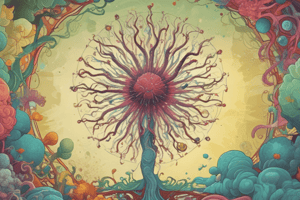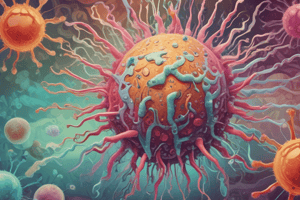Podcast
Questions and Answers
What is the primary mechanism by which the influenza virus acquires genetic variation?
What is the primary mechanism by which the influenza virus acquires genetic variation?
- Antigenic shift
- Reassortment (correct)
- Antigenic drift
- Point mutation
Which of the following is a characteristic of antigenic drift?
Which of the following is a characteristic of antigenic drift?
- Recombination of viral genes
- Gradual accumulation of point mutations over time (correct)
- Sudden and drastic change in the virus's antigenic properties
- Exchange of genetic material between different viruses
What is the primary mode of transmission of the influenza virus?
What is the primary mode of transmission of the influenza virus?
- Fomite transmission
- Direct contact transmission
- Vector-borne transmission
- Airborne transmission (correct)
Which of the following is a recommended method for preventing the spread of influenza?
Which of the following is a recommended method for preventing the spread of influenza?
What is the term for the process by which the influenza virus undergoes a sudden and drastic change in its antigenic properties?
What is the term for the process by which the influenza virus undergoes a sudden and drastic change in its antigenic properties?
What is the main function of the hemagglutinin protein in the influenza virus?
What is the main function of the hemagglutinin protein in the influenza virus?
What is the primary cause of influenza symptoms?
What is the primary cause of influenza symptoms?
Which of the following is a characteristic of the influenza virus genome?
Which of the following is a characteristic of the influenza virus genome?
What is the term for the exchange of genetic material between different influenza viruses?
What is the term for the exchange of genetic material between different influenza viruses?
What is the primary goal of hand hygiene practices in preventing the spread of influenza?
What is the primary goal of hand hygiene practices in preventing the spread of influenza?
Flashcards are hidden until you start studying
Study Notes
Influenza Virus Characteristics
- Helical and spherical in shape
- Genome: -ve sense ssRNA, segmented into 8 segments
- Envelope has Haemagglutinin (HA) and Neuraminidase (NA) glycoprotein spikes
- Infects through the respiratory route
Viral Surface Antigens
- HA (Haemagglutinin) spike: 18 types, most common are H1, 2, 3, 5 (human strains), coded by genome segment 4
- NA (Neuraminidase) spike: 11 types, most common are N1, 2 (human strains), coded by genome segment 6
- Both spikes on envelope (10 nm long) and undergo antigenic variations
Classification and Structure
- Family classification: contains 3 genera of influenza virus: A, B, C, based on antigenic differences in Nucleocapsid (NP) and Matrix proteins
- NP responsible for helical symmetry, while Matrix proteins (M1) responsible for spherical shape
- M2 protein (ion channel) facilitates uncoating of the virus
Genus Influenza A Subtypes
- Subdivided into subtypes based on antigenic variations of HA and NA surface glycoproteins (18H and 11N)
Genome
- Negative sense single-stranded RNA, segmented into 8 segments
Haemagglutinin (HA) Functions
- Viral attachment protein: binds to sialic acid receptors on respiratory epithelial cell surface
- Promotes fusion of the envelope to the cell membrane
- Hemagglutinates human, chicken, and guinea pig RBCs
- Elicits protective neutralizing antibody response
Neuraminidase (NA) Functions
- Destroys neuraminic acid of mucin covering sialic acid receptors on respiratory epithelial cell surface
- Cleaves sialic acid on glycoproteins, including cell receptor, to facilitate infection and release of virus from infected cells
- Target for antiviral drugs: zanamivir (Relenza) and oseltamivir (Tamiflu)
Studying That Suits You
Use AI to generate personalized quizzes and flashcards to suit your learning preferences.




